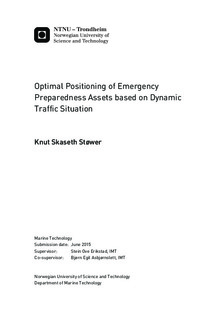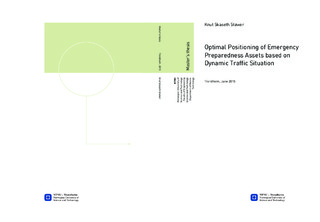| dc.contributor.advisor | Erikstad, Stein Ove | |
| dc.contributor.advisor | Asbjørnslett, Bjørn Egil | |
| dc.contributor.author | Støwer, Knut Skaseth | |
| dc.date.accessioned | 2015-10-05T15:04:39Z | |
| dc.date.available | 2015-10-05T15:04:39Z | |
| dc.date.created | 2015-06-10 | |
| dc.date.issued | 2015 | |
| dc.identifier | ntnudaim:12627 | |
| dc.identifier.uri | http://hdl.handle.net/11250/2350835 | |
| dc.description.abstract | The objective of this thesis is to create a method that utilizes mathematical
models and tools to measure the threat posed to the environment by the merchant
traffic along the Norwegian coast. This is done so that operators at Vessel
Traffic Service(VTS) centers in Norway can assess dangers and allocate emergency
assets to the correct areas so that the existing assets are utilized to their
potential. If the existing emergency assets are utilized fully, the risk of
catastrophic accidents is minimized.
The thesis looks specifically at merchant vessel positions along the Norwegian
coast at a given point in time. Using this information I calculate a criticality
value for different areas so that they can be prioritized according to this
value. The criticality takes into account the merchant vessels positions and
other characteristics like its type and position relative to regional
characteristics such as like currents or skerries. Merchant vessels are grouped
together in zones so that the operators can see where they need to pay closer
attention or allocate emergency assets to reduce the total risk of any incident
leading to catastrophic accident.
An optimization model is then developed to find the optimal position of one or
more emergency assets based on the criticality that gets used as a demand or
a weight for each zone. Five potential sites for home port for the emergency
assets were selected and the optimization model found the optimal location based
on the calculated criticalities.
A second formulation was created to better support the location of several
emergency assets, and this was used to find the optimal location for two
emergency assets based on the distance to all the zones and the zones
criticality.
The optimal solutions were analyzed using two methods for quantifying the
preparedness. These methods takes into account the criticality of each zone and
the location of an emergency asset as well as the speed of the emergency assets.
This is used to find what zones are covered by the different assets and
a comparison is done between the zones and between the methods on the solution
found by the optimization model.
The analysis shows that the methods show good promise and the visualization is
helpful in determining critical areas. However, there are many opportunities
for improving on the methods which is discussed in the discussion and further
work chapters. | |
| dc.language | eng | |
| dc.publisher | NTNU | |
| dc.subject | Marin teknikk, Marin prosjektering | |
| dc.title | Optimal Positioning of Emergency Preparedness Assets based on Dynamic Traffic Situation | |
| dc.type | Master thesis | |
| dc.source.pagenumber | 118 | |

